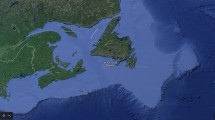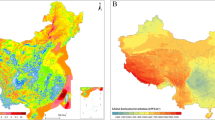Abstract
Energy requirements constitute a significant cost in groundwater production and can also add to a large carbon footprint when fossil fuels are used for power. Wind-enabled water production is advantageous as it minimizes air pollution impacts associated with groundwater production and relies on a renewable resource. Also, as groundwater extraction represents a deferrable load (i.e., it can be carried out when energy demands within an area are low), it provides a convenient way to overcome the intermittency issue associated with wind power production. Multiple turbine wind farms are needed to generate large quantities of power needed for large-scale groundwater production. Turbines must be optimally located in these farms to ensure proper propagation of kinetic energy throughout the system. By the same token, well placement must reconcile the competing objectives of minimizing interferences between production wells while ensuring the drawdowns at the property boundary are within acceptable limits. A combined simulation–optimization based model is developed in this study to optimize the combined wind energy and water production systems. The wind farm layout optimization model is solved using a re-sampling strategy, while the well field configuration is obtained using the simulated annealing technique. The utility of the developed model is to study wind-enabled water production in San Patricio County, TX. Sensitivity analysis indicated that identifying optimal placement of turbines is vital to extract maximum wind power. The variability of the wind speeds has a critical impact on the amount of water that can be produced. Innovative technologies such as variable flow pumping devices and aquifer storage recovery must be used to smooth out wind variability. While total groundwater extraction is less sensitive to uncertainty in hydrogeological parameters, improper estimation of aquifer transmissivity and storage characteristics can affect the feasibility of wind-driven groundwater production.








Similar content being viewed by others
References
Barthelmie R (1999) The effects of atmospheric stability on coastal wind climates. Meteorol Appl 6(1):39–47
Benitez LE, Benitez PC, Van Kooten GC (2008) The economics of wind power with energy storage. Energy Econ 30(4):1973–1989
Bertsimas D, Tsitsiklis J (1993) Simulated annealing. Stat Sci 8(1):10–15
Black M, Strbac G (2007) Value of bulk energy storage for managing wind power fluctuations. IEEE Trans Energy Convers 22(1):197–205
Brutsaert W (2005) Hydrology: an introduction. Cambridge University Press, Cambridge
Castronuovo ED, Lopes JAP (2004) Optimal operation and hydro storage sizing of a wind-hydro power plant. Int J Electr Power Energy Syst 26(10):771–778
Chowdhury AH, Wade S, Mace RE, Ridgeway C (2004) Groundwater availability model of the central gulf coast aquifer system: numerical simulations through 1999. Texas Water Development Board, Austin
Chowdhury S, Zhang J, Messac A, Castillo L (2012) Unrestricted wind farm layout optimization (UWFLO): investigating key factors influencing the maximum power generation. Renew Energy 38(1):16–30
Coppola EA, Szidarovszky F, Davis D, Spayd S, Poulton MM, Roman E (2007) Multiobjective analysis of a public wellfield using artificial neural networks. Ground Water 45(1):53–61
Elkinton CN, Manwell JF, McGowan JG (2008) Algorithms for offshore wind farm layout optimization. Wind Eng 32(1):67–84
Fowler KR, Reese JP, Kees CE, Dennis J Jr, Kelley CT, Miller CT, Audet C, Booker AJ, Couture G, Darwin RW, Farthing MW, Finkel DE, Gablonsky JM, Gray G, Kolda TG (2008) Comparison of derivative-free optimization methods for groundwater supply and hydraulic capture community problems. Adv Water Resour 31(5):743–757
Gonzalez JS, Gonzalez Rodriguez AG, Mora JC, Santos JR, Payan MB (2010) Optimization of wind farm turbines layout using an evolutive algorithm. Renew Energy 35(8):1671–1681
Gonzalez-Longatt FM, Wall P, Regulski P, Terzija V (2012) Optimal electric network design for a large offshore wind farm based on a modified genetic algorithm approach. IEEE Syst J 6(1):164–172
Grady S, Hussaini M, Abdullah M (2005) Placement of wind turbines using genetic algorithms. Renew Energy 30(2):259–270
Hernandez EA, Uddameri V, Arreola MA (2013) A multi-media planning model for assessing co-located energy and desalination plants. Environ Earth Sci. doi:10.1007/s12665-013-2906-x
Hsu S, Meindl EA, Gilhousen DB (1994) Determining the power-law wind-profile exponent under near-neutral stability conditions at sea. J Appl Meteorol 33:757–772
Jensen NO (1983) A note on wind generator interaction. Risø National Laboratory, Roskilde
Kirkpatrick S, Gelatt JD, Vecchi MP (1983) Optimization by simulated annealing. Science 220(4598):671–680
Kusiak A, Song Z (2010) Design of wind farm layout for maximum wind energy capture. Renew Energy 35(3):685–694
Lackner MA, Elkinton CN (2007) An analytical framework for offshore wind farm layout optimization. Wind Eng 31(1):17–31
Madsen H, Refsgaard A, Falk AK (2009) Energy optimization of well fields. Ground Water 47(6):766–771
McKinney DC, Lin MD (1994) Genetic algorithm solution of groundwater management models. Water Resour Res 30(6):1897–1906
Monteiro C, Bessa R, Miranda V, Botterud A, Wang J, Conzelmann G (2009) Wind power forecasting: State-of-the-art 2009, Report ANL/DIS-10-1, 2009. Argonne National Laboratory. www.dis.anl.gov/projects/windpowerforecasting.html
NAP (1997) Valuing ground water: economic concepts and approaches. The National Academy Press, Washington, DC
NREL (2013) Wind resource assessment. National Renewable Energy Laboratory. http://www.nrel.gov/wind/resource_assessment.html. Accessed 5 Jan 2013
Shafer G, Baker E Jr (1973) Ground-water resources of Kleberg Kenedy, and southern Jim Wells counties, Texas. Report 173. Texas Water Development Board, Austin
Sophocleous M (2002) Interactions between groundwater and surface water: the state of the science. Hydrogeol J 10(1):52–67
SPMWD (2011) 196 Wind turbines cranking out power. San Patricio Muncipal Water District. http://sanpatwater.com/news12.15.10.php. Accessed 5 Jan 2013
Todd DK, Mays LW (2005) Groundwater hydrology edition, 3rd edn. Wiley, New Jersey
Turner J (1972) On the energy deficiency in self-preserving convective flows. J Fluid Mech 53:217–226
Uddameri V (2007) Using statistical and artificial neural network models to forecast potentiometric levels at a deep well in South Texas. Environ Geol 51(6):885–895
Uddameri V, Honnungar V (2007) Combining rough sets and GIS techniques to assess aquifer vulnerability characteristics in the semi-arid South Texas. Environ Geol 51(6):931–939
Uddameri V, Singaraju S, Hernandez EA (2013) Impacts of sea-level rise and urbanization on groundwater availability and sustainability of coastal communities in semi-arid South Texas. Environ Earth Sci. doi:10.1007/s12665-013-2904-z
Varljen MD, Shafer JM (1993) Coupled simulation-optimization modeling for municipal ground-water supply protection. Ground Water 31(3):401–409
Vermeer L, Sørensen JN, Crespo A (2003) Wind turbine wake aerodynamics. Prog Aerosp Sci 39(6):467–510
Wang M, Zheng C (1998) Ground water management optimization using genetic algorithms and simulated annealing: formulation and comparison. JAWRA J Am Water Resour Assoc 34(3):519–530
Author information
Authors and Affiliations
Corresponding author
Rights and permissions
About this article
Cite this article
Hernandez, E.A., Uddameri, V. & Singaraju, S. Combined optimization of a wind farm and a well field for wind-enabled groundwater production. Environ Earth Sci 71, 2687–2699 (2014). https://doi.org/10.1007/s12665-013-2907-9
Received:
Accepted:
Published:
Issue Date:
DOI: https://doi.org/10.1007/s12665-013-2907-9




